Std 12 Geography Chapter 8 Question Answer Geography: Nature and Scope Maharashtra Board
Balbharti Maharashtra State Board Class 12 Geography Solutions Chapter 8 Geography: Nature and Scope Textbook Exercise Questions and Answers.
Class 12 Geography Chapter 8 Geography: Nature and Scope Question Answer Maharashtra Board
Geography Class 12 Chapter 8 Question Answer Maharashtra Board
1. Identify the correct group.
Question 1.
| A | B | C | D |
| Geomorphology | Cartography | Tourism | Political Geography |
| Climatology | Survey Forest | Conservation | Physical Geography |
| Biogeography | Data collection | Wildlife Conservation | Population Geography |
| Historical Geography | GIS/GPS | Culture Conservation | Economic Geography |
Answer:
B
![]()
Question 2.
| A | B | C | D |
| History | Economics | Biogeography | Geomorphology |
| Sociology | Geology | Population Geography | GIS |
| Demography | Remote sensing | Cartography | Demography |
| Political Science | Climatology | Psychology | Pedology |
Answer:
A
2. Give geographical reasons.
Question 1.
Human Geography is multidisciplinary in nature.
Answer:
- Human geography is the branch of geography dealing with human activities and their influence on culture, communities and economies.
- In human geography every social science studies separately has interface with branch of human geography; because of their spatial attributes.
- Social sciences like sociology, political science, economics, history and demography are very closely related with branches of human geography, such as social geography, political geography, economic geography and historical geography, respectively.
- Since, we study varied branches of geography in human geography, it is said to be multidisciplinary in nature.
Question 2.
Geography is dynamic in nature.
Answer:
- Most geographical phenomena whether physical or human are not static and can change overtime.
- In economic geography, we study economic activities as well as factors affecting their distribution and changes.
- In climatology we study changes in temperature and rainfall due to global warming. Depending upon the changes in climate, changes are made in cropping patterns.
- Geographers study relationship between production, distribution and geographical factors.
- For example, tea is grown on a large scale in the State of Assam due to high temperature, heavy rainfall, red soil, hilly relief, cheaper water transportation due to the Brahmaputra River and cheap and skilled labour supply from nearby States of Bihar and Orissa.
- We study weather over a period of about 30 years and decide climate of that place or population of a country or the world over a period of time. Since, changes occur time to time.
Thus, geography is dynamic in nature.
Question 3.
Geography is dualistic in nature.
Answer:
- There are two contrasting approaches to study the subject of geography. They are possibilism and environmental determinism. This contrast in approaches is called as dualism in geography.
- Some geographers are of the view that nature is more dominant than man. It is called environmental determinism. According to them, when we study geography, we study the earth. We study how natural resources have influence on economic activities, as well as food habits of people.
- For example, in coastal areas fishing activity is more developed and fish is the main food of the people.
- Some geographers are of opinion that man dominates the nature. It is called possibilism. According to them man can make changes in nature due to his intelligence.
- For example, there are polyhouses even in polar areas, in which temperature is controlled artificially and vegetables are grown.
- There are many other thinkers who have different approaches in geography.
Thus, the study of geography is dualistic in nature.
![]()
3. Write short notes on.
Question 1.
Physical Geography is related to various branches of science.
Answer:
- Almost every discipline, under natural and social sciences is linked with geography.
- Geomorphology, Climatology, Oceanography and Biogeography are the branches of physical geography.
- Geomorphology studies landforms, rock types, processes of formation of rocks, landforms, etc. Therefore, it is related to geology.
- Climatology studies elements of atmosphere such as temperature, winds, rainfall, humidity, natural disasters like cyclones, anticyclones, storms, etc. Therefore, it is related to meteorology.
- Oceanography studies oceans and seas on the surface of the earth, ocean currents, ocean routes, etc. Therefore, it is related to Hydrology.
- Biogeography studies the distribution of plants and animals, their species, ecosystems, etc. Therefore, it is related to biology.
- Knowledge of mathematics is important for cartographic techniques, such as drawing of maps and diagrams. Similarly, knowledge of statistics is useful to do data analysis since various statistical techniques and hypotheses testing are used in data analysis.
- Thus, physical geography is related to various branches of sciences.
Question 2.
Branches of Geography.
Answer:
- There are three major branches of Geography – Physical Geography, Human Geography and Geographic Techniques.
- Geography has various sub-branches; however, the four major sub-branches of Physical Geography are Geomorphology, Climatology, Biogeography and Oceanography.
- Human geography comprises of six sub-branches, Historical Geography, Political Geography, Economic Geography, Behavioural Geography, Social Geography and Population Geography.
- Geographic Techniques have four branches, namely, remote sensing, quantification methods in geography, cartography and Geographic Information System (GIS).
Question 3.
Latest trends in Geography.
Answer:
- Currently, the explanation of all geographic phenomena depends upon the cause and effect relationship.
- Geographers developed number of disciplines within its boundaries.
- Number of techniques for analysis and prediction through data collection and modelling are also developed by geographers.
- Due to the dynamic nature of geography, new things are added in the subject.
- Use of audio-visual media and information technology has enriched the database.
- The latest technology of software has brought about better opportunities in data collection, interpretation, analysis and presentation.
- Presently, the Use of GIS and GPS has become essential. Therefore, maps are made by using GIS software and have proved to be more accurate.
- Nowadays the use of mathematical modelling and computer models in applied geography has increased. They are used for prediction of weather changes or natural calamities.
- The above mentioned are all the latest trends in Geography.
Question 4.
Skills required for studying geography.
Answer:
- The skills required to study the methods and techniques used in geography have made the study of geography empirical and practical in nature.
- The study of geography is based on theory and observation. It is supported by the scientific study like data collection and data analysis through number of tools and techniques.
- The geographers developed skills for conducting surveys with the help of advanced technology. They have also acquired the skills to make use of satellite images for data collection.
- The geographers have attained the skills for experiments, data collection, data organisation, observation patterns, data analysis, research findings, etc.
- The geographers have learnt analytical techniques of data with the help of statistical techniques and representation of statistical data using graphs and maps.
![]()
4. Answer the following questions in detail.
Question 1.
Explain how the knowledge of Geography is important in our day-to-day life. Give examples.
Answer:
- The knowledge of geography is important in our day-to-day life because with geographical knowledge we can understand the basic physical systems that affect our everyday life.
For example, the earth-sun relationship, water cycle, wind, ocean currents, etc. - For the effective functioning of different places, we learn the physical and cultural characteristics of places.
- With the help of geography, we can understand the geography of the past, how geography had played an important role in the evolution of people, their ideas, places and environment.
- We can prepare a map of a province or territory, country and the world, so that one can understand the location of various countries. For example, the political map of the Asian continent gives idea about location of Asian countries.
- With the help of various distribution maps, we can understand distribution of minerals, crops, population, etc., in the world. For example, with the help of dot map we can understand spatial distribution of population in the world.
- With the help of economic geography, we can understand the development of economic activities in different countries of the \yorld and their correlation with physical and economic factors. For example, we can study the world’s leading areas in fishing activities and their reasons.
- With the help of climatology, we understand atmospheric phenomenon, such as cyclones, global warming, etc.
- The study of sustainable development in geography teaches us to appreciate the earth as humankind’s homeland and provide an insight for wise management decisions about the usage of the earth’s resources.
- With the help of geography, we can understand global inter-dependence to become a better global citizen.
- Thus, with the help of geography, we can study physical features, economic activities, trade, people, etc., in the world.
Question 2.
Discuss the relationship between Geography and other subjects.
Answer:
- Geography is related to almost every discipline under natural and social sciences. There are three major branches of Geography, namely, Physical Geography, Human Geography and Geographic Techniques.
- Geography has various sub-branches; however, the four major sub-branches of Physical Geography are Geomorphology, Climatology, Biogeography and Oceanography.
- In Geomorphology we study the formation and types of landforms, gradient, rock structure, etc. This is related to the subject of geology.
- In Climatology we study the atmospheric elements such as temperature winds, rainfall, humidity, natural disasters like cyclones, anticyclones, storms, etc. This it is related to the subject of meteorology.
- In Oceanography we study the ocean currents, ocean routes, coastal features, submarine relief, etc., of oceans and seas. This it is related to the subject of hydrology.
- In geography of soil, we study the components, layers, texture, and fertility of the soil, etc. This is related to the subject of pedology.
- Human geography comprises of six sub-branches, Historical Geography, Political Geography, Economic Geography, Behavioural Geography, Social Geography and Population Geography. In historical geography, we study the correlation of historical events with geographical factors. This is related to the subject of history.
- In Political Geography, we study the effect of geographical factors on political events. This is related to the subject of political science.
- In Economic Geography, we study the correlation of geographical factors and economic activities. This is related to the subject of economics.
- Similarly, Behavioural Geography, Social Geography and Population Geography are related to the subjects of psychology, sociology and demography respectively.
- Thus, it can be concluded by saying that geography has a strong relationship with other subjects in natural as well as human or social sciences.
![]()
Question 3.
Explain the nature of Geography in detail.
Answer:
- Geography is the study of the earth as a home of man, and various phenomena related to it.
- Therefore, geography is the study of the physical environment in relation to man. The physical environment has direct effect on cultural and social environments.
- The earth is dynamic in nature. Hence, we find variations in its physical and cultural/social environments.
- In geography we study the relation between the physical environment and production, distributions and their patterns and variations.
- Geographers study the location, geographical phenomena, whether physical or human, which are highly dynamic and its causes.
- Since geography is the study of space and time it makes geography dynamic in nature.
- In geographical study, the geographer tries to answer questions like what, why, where and when.
5. Differentiate between.
Question 1.
Physical Geography and Human Geography
Answer:
| Physical Geography | Human Geography |
| (i) Physical Geography is the branch of geography dealing with natural features. | (i) Human Geography is the branch of geography dealing with how human activities influence the culture, communities, economies, etc. |
| (ii) Geomorphology, Climatology, Oceanography, Biogeography, Geography of soils, are the branches of Physical Geography. | (ii) Historical Geography, Political Geography, Economic Geography, Behavioural Geography, Social Geography and Population Geography are the branches of Human Geography. |
| (iii) Physical geography is natural science. | (iii) Human geography is a social science. |
Question 2.
Possibilism and Determinism.
Answer:
| Possibilism | Determinism |
| (i) When man dominates nature, it is called possibilism. | (i) When nature dominates man, it is called determinism. |
| (ii) Due to intelligence, man makes changes in the natural environment. | (ii) Determinism asserts that development of human history, culture, society, lifestyle, etc., are shaped by their physical environment. |
| (iii) There are limitations to changes made by man in nature. | (iii) There are no limitations on impact of physical environment on human activities. |
![]()
6. Draw a neat and well-labelled diagrams
Question 1.
Relationship between Geography and other subjects.
Answer:
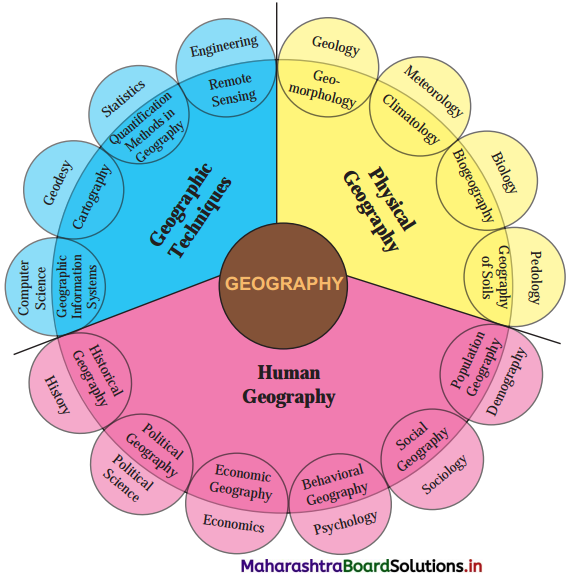
Question 2.
Skills required to study Geography.
Answer:
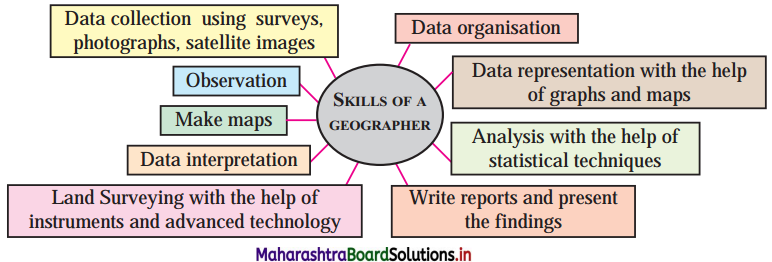
Class 12 Geography Chapter 8 Geography: Nature and Scope Intext Questions and Answers
Let’s recall
Question 1.
Dear students, you have been studying geography either as a part of Environmental Studies since Standard III or as Social Studies since Standard VI and as an independent subject since Standard XI. Your journey to understand our homeland earth began with the study of the cardinal directions in Standard III. In the consecutive academic years, you learnt various geographical concepts. Now just recall the various concepts that you have learnt till now and make a list of them. Also classify them under different categories given in the table 8.3. (Textbook Page No. 75)
Answer:
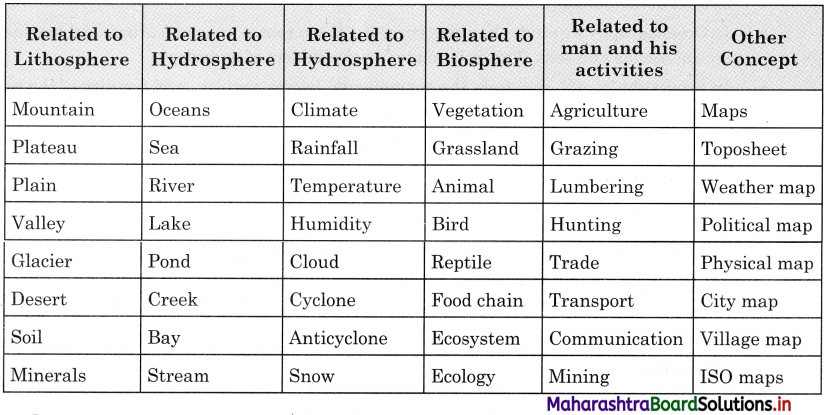
![]()
Can you tell?
Discuss the following points in class with reference to its importance in the subject matter of Geography. (Textbook Page No. 77)
Question 1.
Environment vs. Man
Answer:
Man and environment are inter-related. The environment influences the life of human beings who in-turn modifies the environment as a result of their growth, dispersal, activities, death, etc. Thus, all living beings including man and their environment are mutually reactive affecting each other in a number of ways and a dynamic equilibrium is possible between the two, i.e., human beings and environment are interdependent. If the natural environment helped in the development of different structures of the society on the one hand, the existence and quality of environment now rests on the responses of these social structures to the environment on the other hand.
The burning issues like quality of environment, disruption of earth’s natural ecosystems, environmental degradation and pollution, ecological imbalances, depletion of resources, etc., can be approached and solved only after considering the value judgments which may be determined by taking into account the consequences of ‘Environmental Improvement Programme’ on the entire society and society’s response towards the programme. However, all these depend on the interest and desire of the society in improving the quality of environment.
The interaction between the environment and man depends largely on the social and political system. The differential interactions are due to the uneven distribution of natural resources, uneven economic and social development, dissimilarities of demographic factors, varying view points of the governments and individuals towards the environment, etc.
Continuous and exceedingly increasing rate of exploitation of natural resources, industrialisation, technological growth, unplanned urbanisation and profit-oriented capitalism by the developed western world are responsible for grave environmental crisis and ecological imbalance not confined to their own countries but to the whole world.
The changes in the relationship between man and environment depend upon the change in organisation and attitude of man. To improve environmental stand and to maintain ecological balance, the following remedies are important
- Rapid growth of population
- Rational use of non-polluted water resources
- Use of organic fertilizers for agricultural growth
- To check soil erosion
- Restoration of forest resources
- To check pollution
![]()
Question 2.
Complete study of India vs. Study of only agriculture in India.
Answer:
[Note: In India, it is not possible to provide a complete study of India and agriculture within the scope of a book.]
Try These
Question 1.
Given here are some of the concepts or subject matter we study in Geography. Write the name of subjects or disciplines you think they are also studied in. Complete the table 8.2. (Textbook Page No. 78)
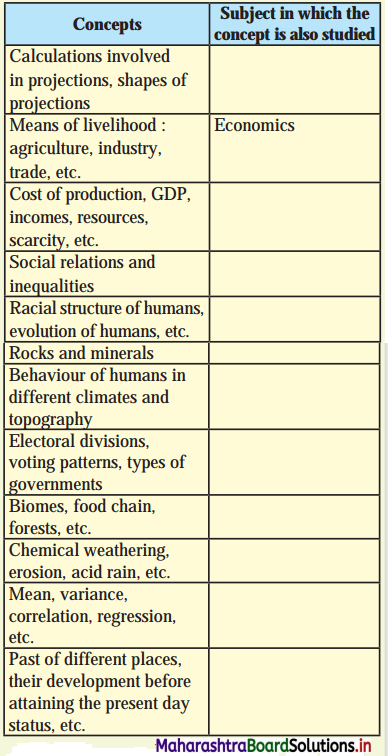
Answer:
| Concepts | Subject in which the concept is also studied |
| Calculations involved in projections, shapes of projections | Cartography |
| Means of livelihood: agriculture, industry, trade, etc. | Economics – Economic Geography |
| Cost of production, GDP, incomes, resources, scarcity, etc. | Economics – Economic Geography |
| Social relations and inequalities. | Sociology – Social Geography |
| Racial structure of humans, evolution of humans, etc. | Anthropology -Human Geography |
| Rocks and minerals | Geology – Geomorphology |
| Behaviour of humans in different climates and topography. | Psychology – Behavioural Geography |
| Electoral divisions, voting patterns, types of governments | Politics – Political Geography |
| Biomes, food chain, forests, etc. | Biology – Biography |
| Chemical weathering, erosion, acid rain, etc. | Geography – Physical Geography |
| Mean, variance, correlation, regression, etc. | Statistics – Statistical Geography |
| Past of different places, their development before attaining the present-day status, etc. | History – Historical Geography |
![]()
Question 2.
In Fig 8.5, a newspaper item is given. A list of job opportunities is given. Go through all the entries and see which ones are suitable for a geographer as a career. (Textbook Page No. 80)
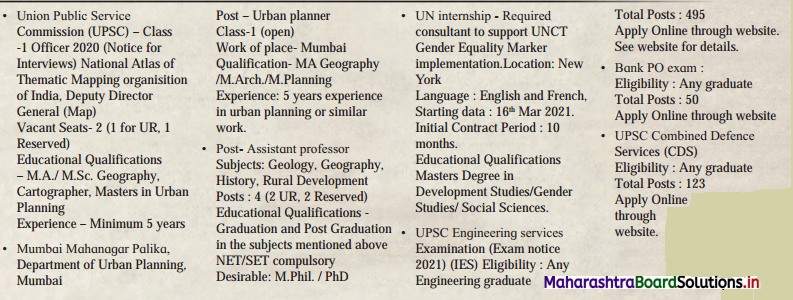
Answer:
The following is the list of jobs opportunities suitable for a geographer as a career.
(i) National Atlas of Thematic Mapping Organisation of India.
(ii) Mumbai Mahanagar Palika, Department of Urban Planning, Mumbai, as Urban Planner
(iii) Assistant Professor in the subject of Geography
For all above posts basic qualification is minimum M.A./M.Sc. in Geography.
Class 12 Geography Solutions Digest
- Population Part 1 Geography Class 12 Question Answer
- Population Part 2 Geography Class 12 Question Answer
- Human Settlements and Land Use Geography Class 12 Question Answer
- Primary Economic Activities Geography Class 12 Question Answer
- Secondary Economic Activities Geography Class 12 Question Answer
- Tertiary Economic Activities Geography Class 12 Question Answer
- Region and Regional Development Geography Class 12 Question Answer
- Geography: Nature and Scope Geography Class 12 Question Answer